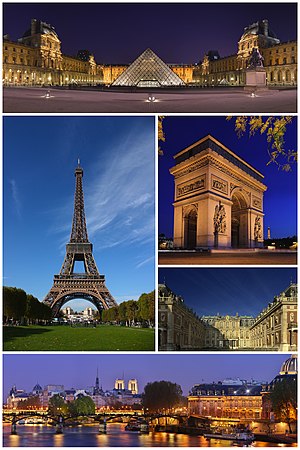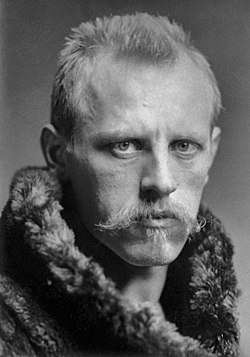Portal:Europe
| Main | Geography | Projects |
|
|
Europe is a continent located entirely in the Northern Hemisphere and mostly in the Eastern Hemisphere. It comprises the westernmost peninsulas of the continental landmass of Eurasia, and is bordered by the Arctic Ocean to the north, the Atlantic Ocean to the west, the Mediterranean Sea to the south, and Asia to the east. Europe is commonly considered to be separated from Asia by the watershed of the Ural Mountains, the Ural River, the Caspian Sea, the Greater Caucasus, the Black Sea, and the waterways of the Turkish Straits. Although much of this border is over land, Europe is generally accorded the status of a full continent because of its great physical size and the weight of history and tradition.
Europe covers about 10,180,000 km2 (3,930,000 sq mi), or 2% of the Earth's surface (6.8% of land area), making it the second smallest continent (using the seven-continent model). Politically, Europe is divided into about fifty sovereign states, of which Russia is the largest and most populous, spanning 39% of the continent and comprising 15% of its population. Europe had a total population of about 741 million (about 11% of the world population), as of 2018. The European climate is largely affected by warm Atlantic currents that temper winters and summers on much of the continent, even at latitudes along which the climate in Asia and North America is severe. Further from the sea, seasonal differences are more noticeable than close to the coast.
The history of Europe concerns itself with the discovery and collection, the study, organization and presentation and the interpretation of past events and affairs of the people of Europe since the beginning of written records. During the Neolithic era and the time of the Indo-European migrations, Europe saw human inflows from east and southeast and subsequent important cultural and material exchange. The period known as classical antiquity began with the emergence of the city-states of ancient Greece. Later, the Roman Empire came to dominate the entire Mediterranean basin. The fall of the Roman Empire in AD 476 traditionally marks the start of the Middle Ages. Beginning in the 14th century a Renaissance of knowledge challenged traditional doctrines in science and theology. Simultaneously, the Protestant Reformation set up Protestant churches primarily in Germany, Scandinavia and England. After 1800, the Industrial Revolution brought prosperity to Britain and Western Europe. The main European powers set up colonies in most of the Americas and Africa, and parts of Asia. In the 20th century, World War I and World War II resulted in massive numbers of deaths. The Cold War dominated European geo-politics from 1947 to 1989. After the fall of the Iron Curtain, the European countries grew together.
The culture of Europe is rooted in the art, architecture, film, different types of music, economic, literature, and philosophy that originated from the continent of Europe. European culture is largely rooted in what is often referred to as its "common cultural heritage".
The economy of Europe comprises more than 744 million people in 50 countries. The formation of the European Union (EU) and in 1999, the introduction of a unified currency, the Euro, brings participating European countries closer through the convenience of a shared currency and has led to a stronger European cash flow. The difference in wealth across Europe can be seen roughly in former Cold War divide, with some countries breaching the divide (Greece, Estonia, Portugal, Slovenia and the Czech Republic). Whilst most European states have a GDP per capita higher than the world's average and are very highly developed (Liechtenstein, Luxembourg, Monaco, Andorra, Norway, Sweden, Denmark, Netherlands, Switzerland, United Kingdom, Ireland, Germany), some European economies, despite their position over the world's average in the Human Development Index, are poorer.
Featured article -
During its 69-year history, the Soviet Union usually had a de facto leader who would not always necessarily be head of state or even head of government but would lead while holding an office such as Communist Party General Secretary. The office of the chairman of the Council of Ministers was comparable to a prime minister in the First World whereas the office of the chairman of the Presidium was comparable to a president. In the ideology of Vladimir Lenin, the head of the Soviet state was a collegiate body of the vanguard party (as described in What Is to Be Done?).
Following Joseph Stalin's consolidation of power in the 1920s, the post of the general secretary of the Central Committee of the Communist Party became synonymous with leader of the Soviet Union, because the post controlled both the Communist Party and, via party membership, the Soviet government. Often the general secretary also held high positions in the government. The post of general secretary lacked clear guidelines of succession, so after the death or removal of a Soviet leader the successor needed the support of the Political Bureau (Politburo), the Central Committee, or another government or party apparatus to both take and stay in power. The President of the Soviet Union, an office created in March 1990, replaced the general secretary as the highest Soviet political office. (Full article...)
Featured location -
Omaha Beach was one of five beach landing sectors of the amphibious assault component of Operation Overlord during the Second World War.
On June 6, 1944, the Allies invaded German-occupied France with the Normandy landings. "Omaha" refers to an 8-kilometer (5 mi) section of the coast of Normandy, France, facing the English Channel, from west of Sainte-Honorine-des-Pertes to east of Vierville-sur-Mer on the right bank of the Douve river estuary. Landings here were necessary to link the British landings to the east at Gold with the American landing to the west at Utah, thus providing a continuous lodgement on the Normandy coast of the Baie de Seine (Bay of the Seine River). Taking Omaha was to be the responsibility of United States Army troops, with sea transport, and a naval bombardment force provided predominantly by the United States Navy and Coast Guard, with contributions from the British, Canadian and Free French navies. (Full article...)
Featured portrait
 |
In the News
- 4 April 2025 – Russo-Ukrainian War
- Russian invasion of Ukraine
- Five people are killed, including a child, and 35 are injured in a Russian drone attack on a residential area in Novobavarskyi District of Kharkiv, Ukraine. (Ukrainska Pravda)
- A Russian ballistic missile strike on a residential area in Kryvyi Rih, Ukraine, kills 18 people, including five children, and injures more than 50 others. The Russian Defence Ministry claims its forces were targeting a "military gathering" in the city. (BBC News) (Ukrainska Pravda) (Reuters)
- 4 April 2025 – Kočani nightclub fire
- The death toll from the fire at a nightclub in Kočani, North Macedonia, in March increases to 60 as a burn victim dies in the hospital. (AP)
- 4 April 2025 –
- Thousands of people demonstrate in Bangui, Central African Republic, to protest against President Faustin-Archange Touadéra's plans to run for a third term with the backing of the Russian-led Wagner Group, who has killed indiscriminately in the country. (AP)
- 3 April 2025 – Tariffs in the second Trump administration
- A 25% tariff on all automotive imports into the United States enters force. No exemptions are announced despite requests from several major trade partners, including Japan and the United Kingdom. (Reuters)
Updated: 5:05, 5 April 2025
Categories
Featured biography -
Fridtjof Wedel-Jarlsberg Nansen (Norwegian: [ˈfrɪ̂tːjɔf ˈnɑ̀nsn̩]; 10 October 1861 – 13 May 1930) was a Norwegian polymath and Nobel Peace Prize laureate. He gained prominence at various points in his life as an explorer, scientist, diplomat, humanitarian and co-founded the Fatherland League.
He led the team that made the first crossing of the Greenland interior in 1888, traversing the island on cross-country skis. He won international fame after reaching a record northern latitude of 86°14′ during his Fram expedition of 1893–1896. Although he retired from exploration after his return to Norway, his techniques of polar travel and his innovations in equipment and clothing influenced a generation of subsequent Arctic and Antarctic expeditions. He was elected an International Member of the American Philosophical Society in 1897. (Full article...)
Featured picture
 |
Related portals
Major Religions in Europe
Northern Europe
Western Europe
Central Europe
Eastern Europe, Balkans and Caucasus
Southern Europe
Featured panorama
 |
Topics
Associated Wikimedia
The following Wikimedia Foundation sister projects provide more on this subject:
-
Commons
Free media repository -
Wikibooks
Free textbooks and manuals -
Wikidata
Free knowledge base -
Wikinews
Free-content news -
Wikiquote
Collection of quotations -
Wikisource
Free-content library -
Wikispecies
Directory of species -
Wikiversity
Free learning tools -
Wikivoyage
Free travel guide -
Wiktionary
Dictionary and thesaurus



























